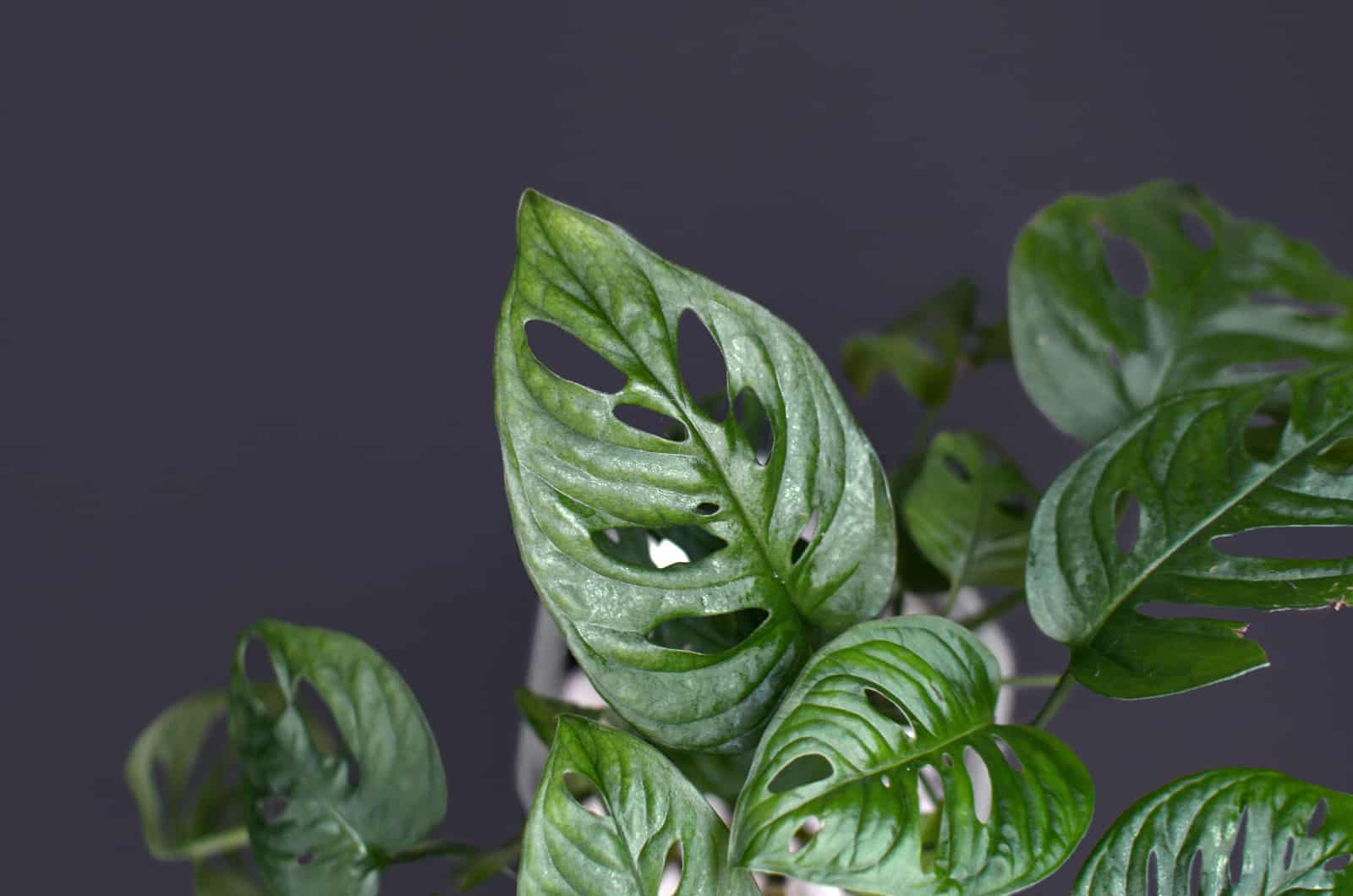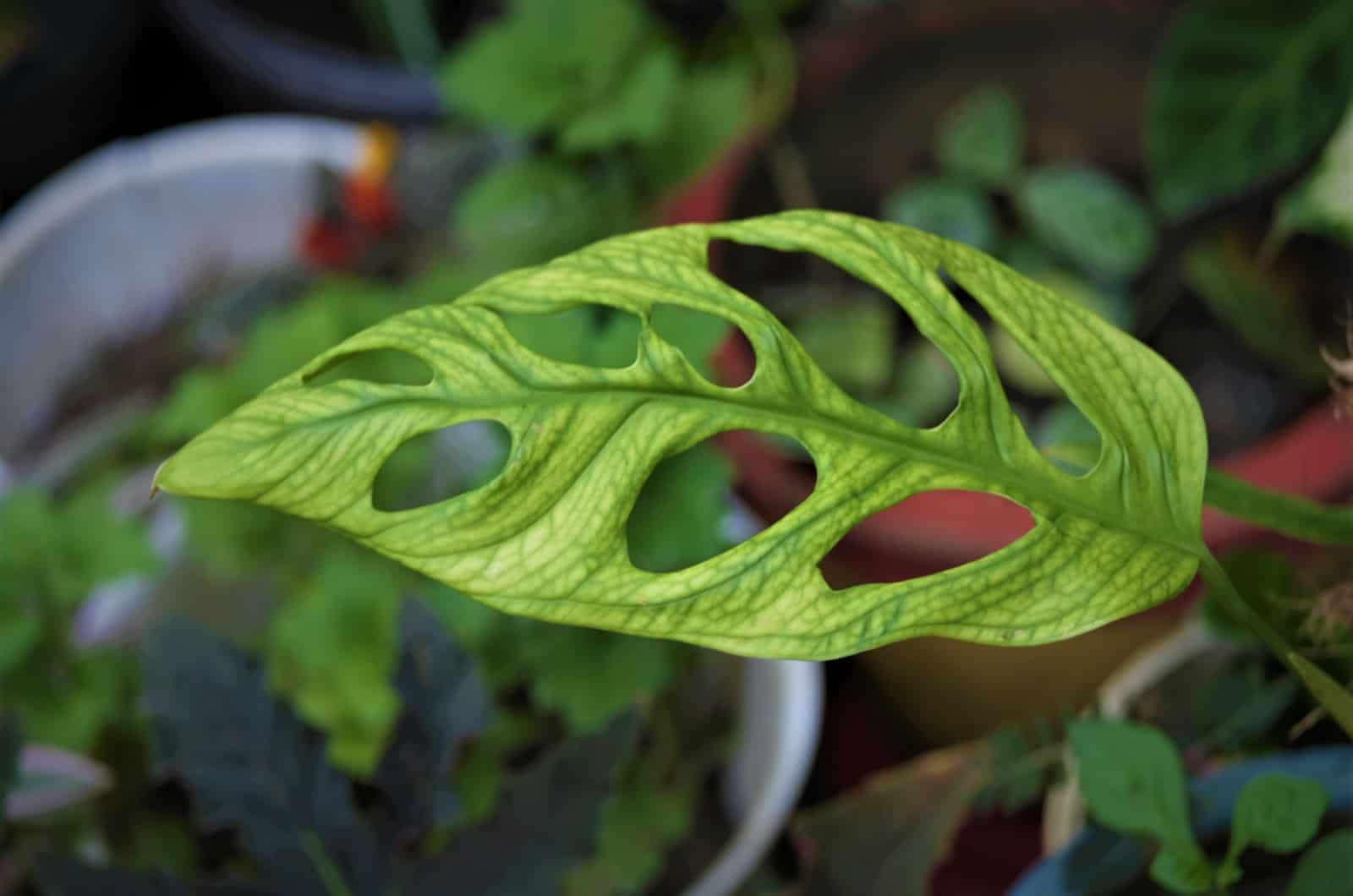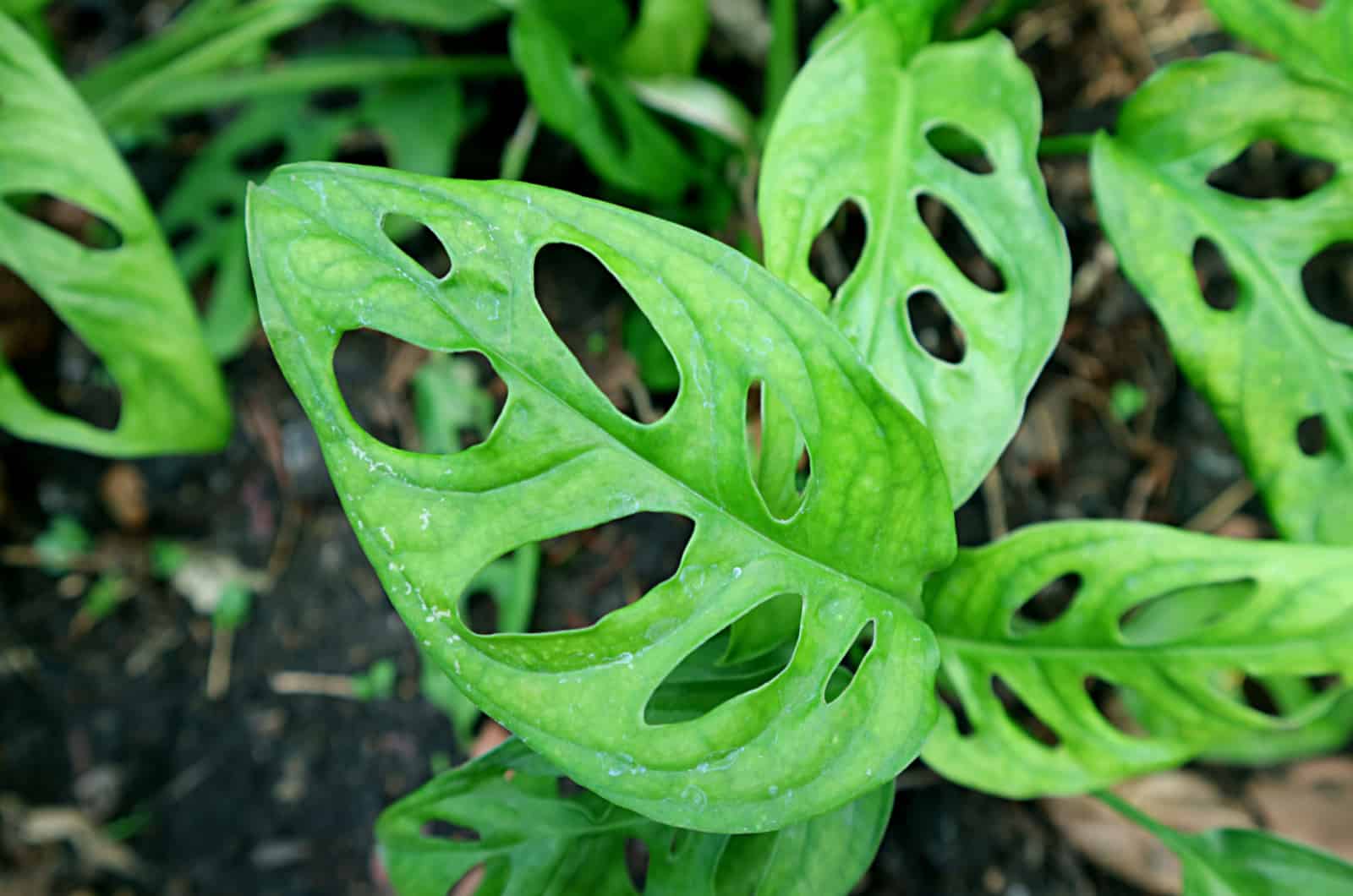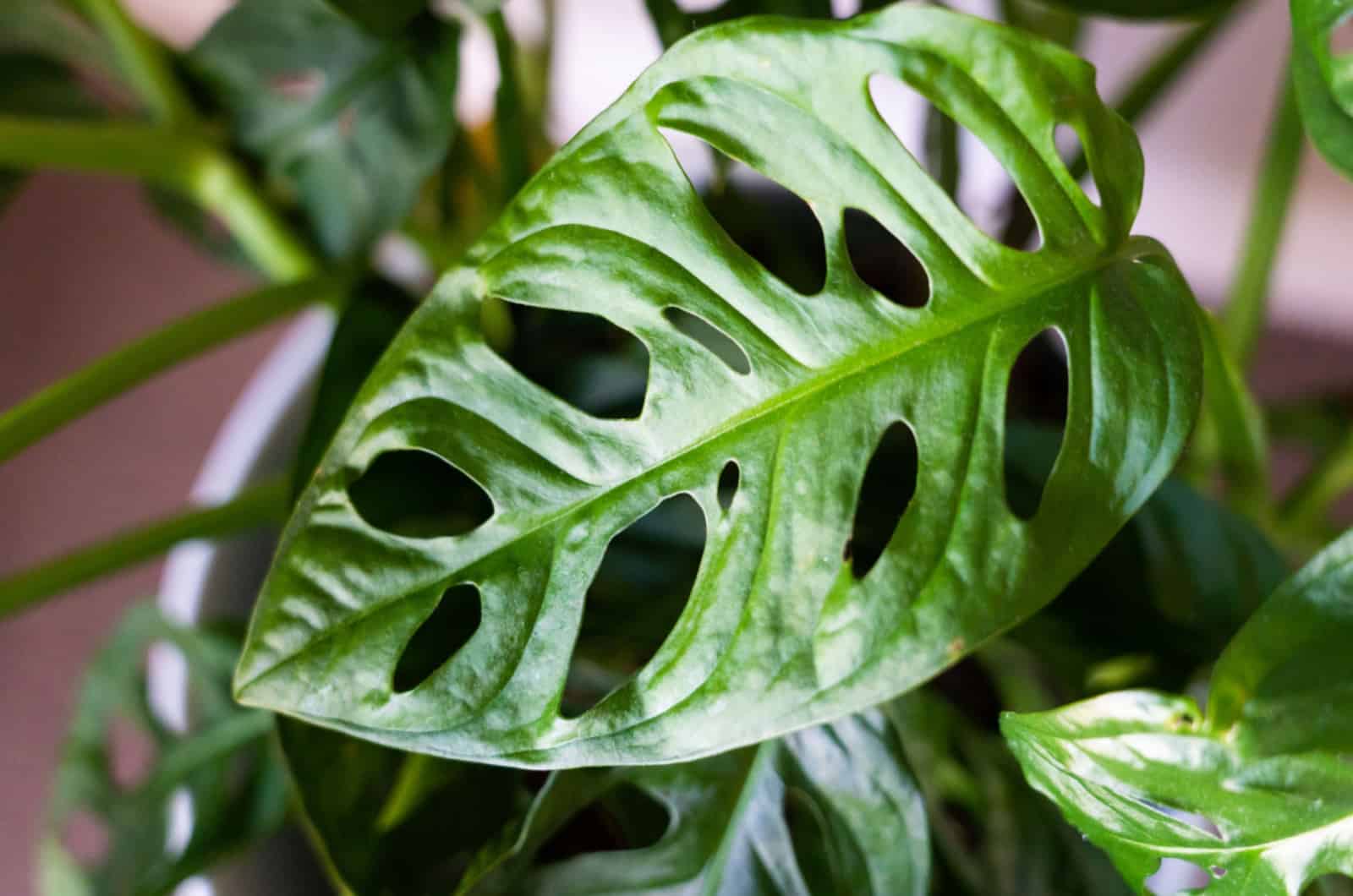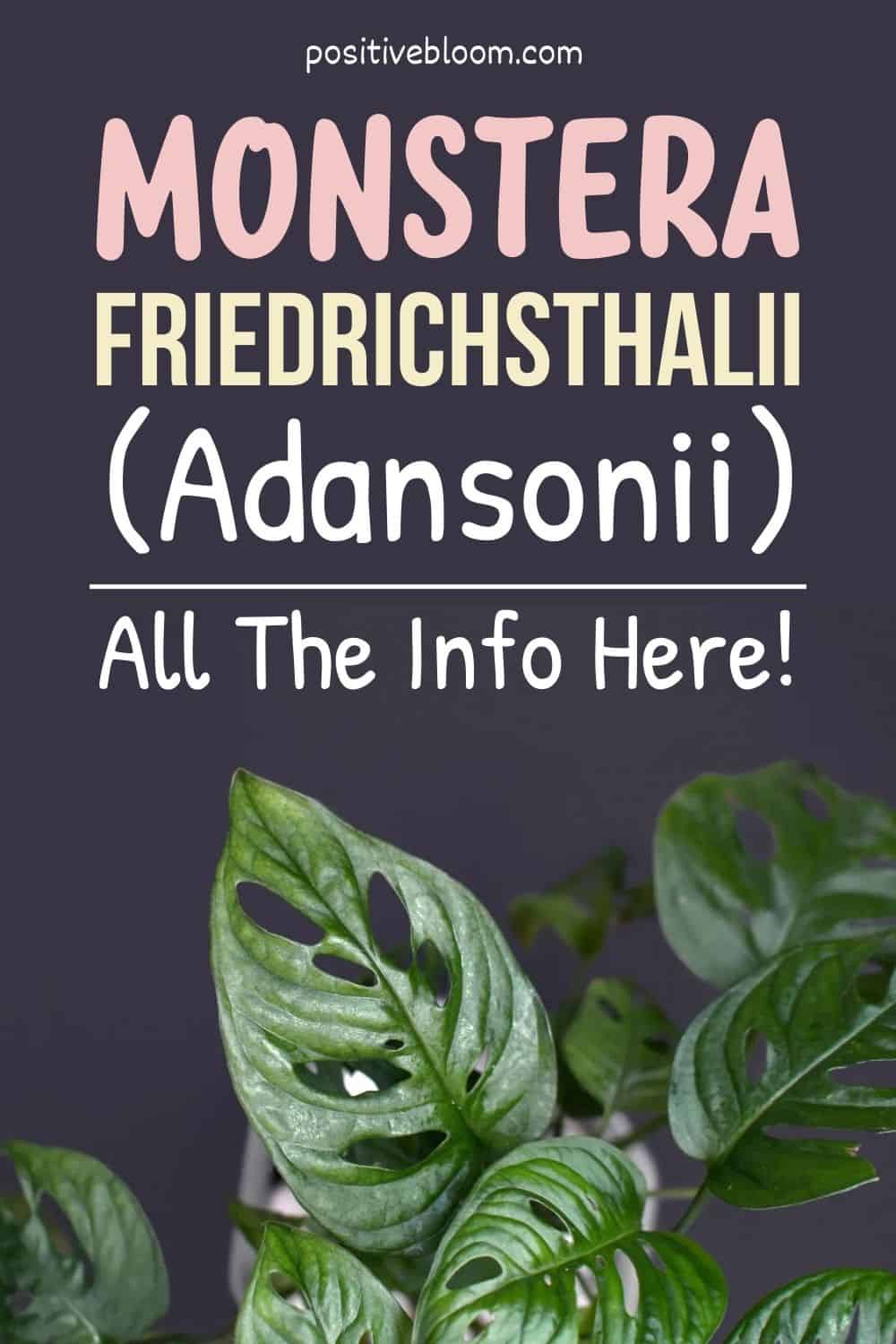There is a Monstera variety out there for each and every household, I’m convinced of it! Only people who don’t like plants (if there even are any) haven’t heard about these stunning houseplants.
An interesting thing about plants from the Monstera genus is that they all have many nicknames, which is probably why they are mistaken for each other.
One of the most beautiful Monstera varieties is the magnificent Monstera friedrichsthalii, commonly known as Monstera adansonii. But those aren’t the only names for this variety – you will also hear many growers refer to it as Swiss cheese plant or vine, Monkey mask, or five holes plant.
Let’s find out all about this Monstera and why it has become so popular alongside the Monstera deliciosa.
Here is some basic info:
[table id=224 /]Let’s begin!
Monstera Friedrichsthalii: Features
All Monsteras look somewhat similar, but when they are side by side it’s easy to identify them.
Let’s find out more about Friedrichsthalii’s appearance.
Leaves
One of the nicknames of this plant will give you a hint about the appearance of the leaves. Adansonii got the nickname Swiss cheese plant because it develops oval-shaped holes in the leaves that resemble those of Swiss cheese.
These holes are known as fenestrations, and they perfectly combine with the heart shape of the leaves.
Don’t worry if your juvenile Monstera hasn’t developed any fenestrations yet, they will appear as the plant matures!
Adansonii leaves are quite large and come in the most beautiful shade of green.
Flowers
I’m sure you’re expecting me to tell you about the color and shape of adansonii flowers, but unfortunately the chances of seeing the adansonii flower as an indoor plant are pretty low.
In its natural habitat, friedrichsthalii produces spathes that aren’t real flowers, but rather distinctive leaf forms that come in a cream color with purple splashes.
Monkey mask doesn’t produce fruit like its close cousin Philodendron Monstera aka Monstera deliciosa.
Growth
Swiss cheese vine is a fast-growing plant that has a vining growth habit.
If you train your Monstera plant to climb, it can reach an incredible 13 feet tall. However, the average size of an indoor five holes plant is usually 3 to 8 feet in height and 1 to 3 feet in width.
Therefore, if you have a relatively small space and can’t decide which plant to grow between deliciosa or adansonii, I recommend adansonii.
Monstera Adansonii Plant Varieties
Remember that new plant varieties are constantly being developed. Adansonii is a stunning low-maintenance plant, so it’s no wonder we have more cultivars.
Here is a list of the most common adansonii subspecies:
Monstera Adansonii Klotzschiana
The leaves of klotzschiana are quite large and can be lanceolate or elongated.
Young leaves often don’t develop perforations, unlike the older ones, which may develop a couple.
Monstera Adansonii Blanchetii
The Blanchetii subspecies is another climber and can be found in Brazil’s rainforests.
Blanchetii’s leaves may have one side significantly smaller than the other.
It occasionally only has three or four holes, while the larger side can have many holes that grow over large and cause leaf splitting.
Monstera Adansonii Adansonii
Yes, it’s a real name! Monstera adansonii adansonii has a fast growth rate and develops large, oval, elongated leaves.
The leaves have full edges (they don’t split) and develop holes. The holes are approximately one inch wide and three inches long.
Monstera Adansonii Care Guide
The Swiss cheese plant is really easy to grow, and once you learn about the conditions it requires it will be a piece of cake to look after.
The Monstera Friedrichsthalii requires bright indirect light, high humidity, warmer temperatures, well-draining and porous potting mix, regular fertilization, and watering when the top 2-3 inches of the soil are dry.
Let’s get into details!
Light Conditions
It’s important to keep in mind that tropical plants thrive under the large leaves of taller plants and receive little direct sunshine.
Despite the fact that this Monstera plant can thrive in low light, I advise placing it in bright indirect light to help the plant grow more quickly and healthily. Low light will likely prevent the adansonii leaves from becoming perforated.
For optimal results, put the plant near an east-facing window.
This will help your Swiss cheese vine receive some direct sunlight in the mornings (which it needs) without being harmed as it will spend the rest of the day only exposed to indirect light.
Alternatively, position your five holes plant near a north-facing window. However, if you decide to put your plant in this location you shouldć consider moving it somewhere else during winter as it might not get enough light.
If your adansonii doesn’t receive enough light in general, consider getting grow lights (available on Amazon). On the other hand, if too much direct sun is a problem for the leaves of your Monkey mask, put a curtain on the window to create some shade.
Humidity Conditions
Monstera adansonii thrives in high humidity, and anything above 50% should work fine.
However, your adansonii will face issues if the humidity drops below this. In fact, it can be detrimental to the health of your plant.
You’ll need to increase humidity levels as most households don’t have such high humidity.
Fortunately, there are a couple of methods with a great success rate when it comes to increasing humidity.
Humidifier
The first method is a bit pricey, but guarantees perfect humidity levels. A humidifier will both boost humidity levels and keep track of them.
The majority of growers prefer more natural ways of increasing humidity.
A combination of a shallow tray, pebbles, and water will provide enough moisture for your adansonii. However, never let the friedrichsthalii’s roots touch the water from the pebble tray as they may quickly rot if they do.
The Swiss cheese vine will also benefit from growing near other plants. Grouping plants will not only make the space look wonderful, but they will also help distribute humidity evenly.
Moving your Monstera to a kitchen or bathroom is another great idea.
A quick and easy method of raising humidity levels is misting. Occasionally mist the Monstera’s leaves, but don’t leave them wet for an extended period or they’ll develop fungal infections.
Temperature Conditions
The recommended temperature range for this Monstera plant is between 65 and 75 degrees Fahrenheit.
Maintaining these temperatures shouldn’t be difficult in the majority of households.
The Monstera friedrichsthalii can survive in temperatures as low as 55 degrees Fahrenheit and as high as 85 degrees Fahrenheit. Still, you’ll need to make sure it’s properly hydrated if the temperature is higher.
Sadly, these plants can’t withstand frost. Bring your Monstera inside if the temperature falls below 50 degrees Fahrenheit.
Adansonii hates chilly drafts, so keep it away from air conditioners and vents. These Monsteras should also be kept away from heaters like radiators and fireplaces because they cannot tolerate sudden temperature changes.
Soil Requirements
All indoor plants need a particular type of soil, and the same goes for adansonii.
The soil must adhere to the following four criteria:
1. pH of the soil should range from 5.5 to 7.0.
2. You must make sure your adansonii’s soil is well-draining.
3. This Monstera thrives in loamy soil, so using compost derived from loam would be quite beneficial.
4. Plenty of organic matter.
Use an aroid-specific soil blend supplemented with perlite for better drainage and peat moss for moisture retention. Peat moss will cause the pH to decrease, but it’s ideal for your adansonii plant because it’s nutrient rich.
You can mix 50% all-purpose potting soil with 30% orchid bark, 10% peat moss, and 10% perlite.
Another great combination for a potting mix is one part peat moss + coco coir, one part perlite + vermiculite, and one part sphagnum moss.
Watering Schedule
Watering is the trickiest part of adansonii care. On one hand, this Monstera doesn’t grow well in dry soil, and on the other, it won’t grow in overly wet soil either.
So, what to do? Your goal is to keep the soil moist but never waterlogged.
The ideal approach would be to water your adansonii thoroughly until all the extra water starts coming out of the drainage holes. Letting the top 2-3 inches of soil dry between waterings is the best way to avoid water issues.
Watering frequency is heavily influenced by temperature, light, and humidity. Of course, the more direct sun your adansonii receives, the faster its soil drains.
The same applies to warmer temperatures, so you’ll need to water your Monstera more during the hot summer months.
Low humidity helps the soil retain moisture, so delay watering until you increase humidity.
Ensure that the soil never dries out completely.
I advise bottom watering or submerging half the pot in water as a watering technique. Make sure that all extra water drains out through the drainage holes, then empty the saucer of any liquid.
Fertilizing
The ideal fertilizing schedule for the Swiss cheese vine is once a month during the growing season.
This Monstera needs all-purpose liquid fertilizer, just make sure to dilute it to half strength.
However, this fertilizing schedule doesn’t apply after you repot your Swiss cheese plant.
You should use fresh soil when repotting, which often contains fertilizer, so wait for about 6 months until you apply it.
Be careful when applying fertilizer, and always read and follow the directions on the label.
Pruning
Pruning isn’t high on the list of priorities when it comes to Monstera plant care. However, it would be best if you remove any damaged leaves, and this includes discolored leaves.
You can control an adansonii’s shape and growth by removing a couple of branches at the beginning of the growing season.
Your Monstera will certainly look better and grow healthier.
Cleaning
I asked my friend, who was a beginner gardener at the time, if she cleaned the leaves of her Monstera. She was surprised to discover that plant leaves need to be cleaned!
Don’t worry, it doesn’t take much time and it isn’t demanding.
I recommend dipping a soft sponge in water and gently rubbing the leaves of your Swiss cheese vine.
Although you may find various products designed for this purpose, I would go with clean water only.
Repotting
Monkey mask plants can become rootbound, but there’s no need to panic if you notice any of the signs.
Your Monstera won’t die straight away, nor will it stop growing. Adansonii should be repotted every two years, and the best time to repot it is in the early spring (beginning of the growing season).
Before you start repotting, you’ll need to prepare a new pot, fresh potting mix, sanitized pruners, and water.
When choosing a pot for your Monstera you must pay attention to pot size – it shouldn’t be much bigger than the first one as the roots can’t withstand too much soil around them.
The new potting mix should also be well-draining and porous.
The first thing you should do is take your adansonii out of its pot – be very gentle as pulling it may damage the roots. Lean the pot to one side and tap it a little bit so your Monkey mask slides out.
Your next goal is removing as much soil as possible from the roots. This is also a great time to check if your Swiss cheese plant has any diseased roots – if it does you must remove them with sanitized pruners.
Fill one-third of the new pot with fresh soil and place your adansonii in the center. Add more soil, water the plant, and that’s it!
Ensure Support
Monstera adansonii looks breathtaking when grown in hanging baskets or as a climbing plant.
The most common way of supporting Monsteras is with moss poles or trellises.
You can also use coco coir or make a climbing wall.
Although your adansonii can grow well without support, sometimes it’s inevitable that you’ll need it.
Mature Monsteras develop aerial roots that need something to attach to. The leaves of these plants are quite large, so the plant might lean over if you don’t ensure it has support.
How To Propagate The Swiss Cheese Plant
The Adansonii was once quite a rare Monstera, but now it’s easily propagated and widely available.
The best propagation method for the Adansonii plant is with stem cuttings. You can also grow it from seeds.
Let’s get into details!
Stem Cuttings
The first thing to learn before you start propagating with stem cuttings is how to take them. I always take the cuttings when pruning my adansonii.
One more piece of advice is to always sanitize the tools you’re going to use for cutting. The most important thing when choosing your adansonii cutting for propagation is to cut one with at least one node.
Thankfully, it makes no difference how you make the cut.
You have two options for planting: put them in water first or plant them directly in the soil.
Let’s take a look at both methods.
Soil Propagation
The ideal soil type for this propagation method should have good drainage but also be porous. You can find recipes for the perfect potting mix above.
Here are the steps:
• Take a container and add soil.
• Dip your adansonii cutting in rooting hormone to speed up root development.
• Make a hole in the soil and put the cutting in it. Remember the nodes I mentioned earlier? Make sure one of them is below the soil surface.
• Cover the bottom part of the cutting (but not the leaves) with a plastic bag. Make a hole in your plastic bag.
• An essential part of this process is choosing a good place for the container with the cutting. You need to put it somewhere it can get bright indirect light.
You should aim for moist soil and mist the adansonii cutting so it’s never without moisture.
Additionally, uncover the cutting a couple of times a week to let it breathe.
Water Propagation
Here are the steps for water propagation:
1. After you make the adansonii cutting, dip it in rooting hormone. Then take a jar and fill it with water.
2. Submerge the bottom part of the cutting in water. Make sure none of the leaves touch the water.
3. Place your jar in bright indirect light.
4. Remember to refresh the water every three days.
New growth should occur quickly, which is your cue to plant the cutting in the soil.
How To Grow Monkey Mask From Seeds
It’s pretty easy to grow a Monkey mask from seeds. The hardest part is actually finding ‘real’ seeds.
When you find them, here’s how to propagate them:
1. Fill a germination tray with proper potting mix. Don’t forget to water it afterward.
2. Put the seeds on the potting mix and add a little potting mix just to cover them.
3. Put a plastic bag (transparent) over the adansonii seeds.
4. Place it in bright indirect light and adequate warmth.
5. It will take about 3 weeks for the adansonii seeds to germinate. Uncover them, wait for about a month or so, and then plant them in their permanent pot.
Swiss Cheese Vine: Common Issues
You shouldn’t face many issues growing the adansonii plant. However, it isn’t pest or disease-free.
Let’s see what can go wrong and how to solve the problem!
Pests And Diseases
The most common pests that invade Monstera adansonii are spider mites and scale.
An alcohol-dipped cotton swab can be used to eliminate spider mites. However, this only works when there are a small number of invaders.
Neem oil is advised if you’re dealing with an infestation of scale or spider mites. Neem oil should be finely misted over the entire surface of the leaves and stems.
Diseases such as leaf spot usually affect indoor plants, and the adansonii is no exception.
If you are dealing with this disease, I recommend using copper-based fungicide as a solution.
Leaf Discoloration
If your adansonii leaves start turning yellow or brown, the most common cause for both issues is overwatering. Additionally, direct sun can also cause yellowing or browning.
If you notice the leaves are becoming yellow or brown, check the light levels and adjust your watering habits to avoid root rot.
FAQs
What is the rarest Monstera?
The rarest plant from the Monstera genus is Monstera obliqua. This plant is a slow-grower, and a mature obliqua can cost over $20,000 – if you can even find one!
Many growers mistake obliqua for adansonii, but obliqua has more holes than leaves (how remarkable) and a slower growth rate than adansonii.
What is the difference between the Monstera adansonii and the Laniata?
Monstera laniata is a subspecies of Monstera adansonii. The two differentiate in size, fenestrations, and leaf color. Adansonii is smaller, has regular green leaves, and sporadic fenestrations, while laniata has symmetrical fenestrations, may grow larger, and has glossier and darker leaves.
What is the most common Monstera?
The most common Monstera plant is the well-known Monstera deliciosa.
What is the difference between Monstera adansonii and Monstera friedrichsthalii?
There have been many great discussions about the differences between adansonii and friedrichsthalii Monsteras. The thing is that there’s no difference, as both terms refer to the same plant!
Many growers use the name friedrichsthalii for mature plants and adansonii in its juvenile stages.
Wrapping Up
The terms Monstera friedrichsthalii, Monstera adansonii, Monkey mask, Swiss cheese plant, Swiss cheese vine, and five holes plant all refer to the same plant!
No matter what you call this Monstera species, you must admit that it’s breathtaking. Luckily, this isn’t a rare plant, so don’t have to wait to add one to your plant collection.
Take good care of it, propagate when you prune, and inspect it regularly, and it will reward you with amazing green leaves and magnificent fenestrations.
Until next time!
Like this post? Share or pin it for later!

